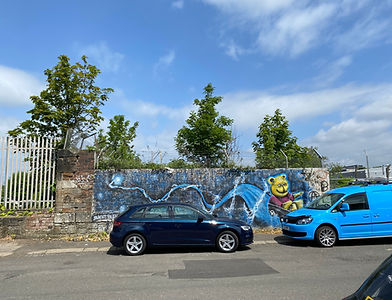
Making sense of decaying spaces
October 23rd, 2023
Conducting research on urban decay and regeneration, especially from a distance, brings both challenges and unexpected discoveries. My work has often relied on a combination of digital tools like Google Maps and official data sources, but as I’ve come to realise, these resources can only provide a partial understanding of the spaces I study. Urban spaces, particularly those in decay, have layers of complexity that are difficult to grasp without a physical presence. The contrast between data and lived experience, especially when exploring derelict or hidden sites, has been a pivotal aspect of my research journey. This autoethnographic account reflects on how my virtual and in-person interactions with decaying spaces in Paisley have shaped my understanding, and how these experiences underscore the importance of grounding research in the tangible reality of the urban environment.
I have now spent countless hours on Google Maps, virtually walking through streets and trying to visualize what the sites looked like, hoping this can make my in-person visits more effective. I am realising that I find it difficult to bridge the gap in understanding between the numbers on the screen and the physical reality of these places, especially when not traversing past the spaces on a daily basis. One experience that really highlighted this elusiveness was when I visited site #350763 on Hamilton Road in Paisley. I had read the data, but it didn’t prepare me for what I encountered. As I walked past, the site was only about 10 meters wide along the street, with a tall concrete wall covered in street art. The wall was so high that I couldn’t see over it without a ladder or something to stand on. Greenery peeked out from the top, suggesting that the space behind had been left unused for quite a long time. From the outside, the site seemed small and unremarkable. However, when I later checked the RVDL Strategy (2022) again, I was surprised to learn that the site was actually 0.66 hectares in size. It was hidden in plain sight—its narrow frontage on the street concealed how deep it ran, extending all the way into the next block. This was a moment of realisation for me, showing how easily the true nature of a site can be obscured by what we see—or don’t see—from the street. It also underscored the limitations of my initial approach to understanding these spaces and the importance of seeing them in person, as well as the complexities involved in making sense of them from a distance or online. This experience was a turning point in my research, reminding me of the importance of grounding data in lived experience and remaining open to the unexpected discoveries that come with exploring these hidden spaces.
Reflecting on my own experiences, I found navigating the site register to be quite challenging, and I encountered several fundamental accessibility issues that hindered my ability to understand the spaces listed. Coming into this research, I approached the register as someone trying to make sense of the sites included, yet I quickly realized how little I knew about the intricacies involved. I had minimal understanding of the value estimations of these sites, their development potential, the necessary planning permits, or the specific steps required to reuse the sites in the register. This lack of knowledge left me feeling overwhelmed and often frustrated, as I struggled to piece together the information needed to comprehend the full scope of possibilities for these spaces. This experience highlighted for me just how complex and opaque the process can be for those not well-versed in the field, and it shaped my approach to my research, making me more empathetic to others who might be facing similar obstacles.
The contrast between the digital representation of spaces and their physical reality has been a humbling and enlightening experience. My encounters with decaying sites, such as #350763 on Hamilton Road, have emphasized the limitations of relying solely on data and virtual tools. The value of direct engagement with these spaces cannot be overstated. As I continue this research, I am reminded of the importance of empathy, not just for the spaces themselves, but for those navigating the often opaque and inaccessible systems surrounding urban redevelopment.


Site #350763 on Hamilton Street in Paisley (source: Renfrewshire Council 2023a, author 2023).